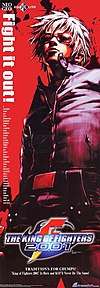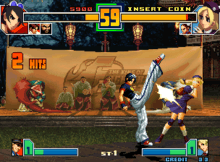The King of Fighters 2001
The King of Fighters 2001[lower-alpha 2] is a fighting game produced by Eolith for the Neo Geo. It is the eighth game in The King of Fighters series, the third and final part of the "NESTS Chronicles" story arc, and the first game produced following the closure of the original SNK. The game was produced by the South Korea-based company Eolith and developed by BrezzaSoft and Eolith, a company formed by former SNK employees. The game was ported to the Sega Dreamcast in Japan only and PlayStation 2. The stand-alone PlayStation 2 version was released in North America in a two-in-one bundle with the preceding game in the series, The King of Fighters 2000. Both the original Neo Geo version and the Sega Dreamcast version were included in The King of Fighters NESTS Hen compilation released for the PlayStation 2 in Japan.
| The King of Fighters 2001 | |
|---|---|
 North American Arcade flyer for the game, depicting the character K' with art by Hiroaki | |
| Developer(s) | Eolith[lower-alpha 1] Playmore (PS2) |
| Publisher(s) |
|
| Director(s) | Lee Sen Ho |
| Producer(s) | Chil Suk Choi |
| Designer(s) | H. Iga |
| Programmer(s) | S. Fujinuki |
| Artist(s) | Hiroaki Hashimoto Nona |
| Writer(s) | Teampow |
| Composer(s) | Kikuko Hataya Masahiko Hataya |
| Series | The King of Fighters |
| Platform(s) | |
| Release | 2001
|
| Genre(s) | Fighting |
| Mode(s) | |
| Cabinet | Upright |
| Arcade system | Neo Geo MVS |
Gameplay

Like in the previous game, the battles are once again between teams of four. Instead of a strict "three fighters and one striker" format, this installment introduces the Tactical Order System, which allows the player to select which characters will they control in combat and which characters will serve as strikers. Before each match, the player can form a team configuration of four fighters and no strikers, to one fighter and three strikers. The number of strikers in one's team will affect the length and number of stocks of the player's Power Gauge. Teams with no strikers will have a longer Power Gauge to fill and can carry only one stock, while a team with only one fighter and three strikers will fill their Power Gauge quicker and carry up to four stocks. One stock can be used to summon a striker, perform a guard or super cancel, a blow-away attack, or a Super Special Move. MAX-level Super Special Moves requires two stocks to perform. Players can now cancel an attack into a Striker Summon with use of a Cancel Striker, while some characters now have Wire Whip techniques which will send an opponent flying into the air and arrive at the other side of the fighting area.
Plot
One year has passed since most of South Town was decimated by the now-destroyed Zero Cannon. Another KOF tournament is being held and this time, it's hosted by the NESTS cartel, the group of antagonists behind the events of the previous two games.
K′ and Maxima return to put an end to NESTS once and for all. They are now joined by former Ikari Warriors Team member Whip and the assassin Lin formerly from Benimaru's Team, both of whom are seeking the destruction of NESTS as well. NESTS sends their own team to compete in the tournament, composed of NESTS agents Kula Diamond, K9999, Foxy, and Angel. Kyo Kusanagi joins his former teammates of Benimaru Nikaido and Goro Daimon, reuniting the original Japan Team along with Shingo Yabuki, while Iori Yagami joins a team composed of agents Seth, Vanessa, and Ramon. Yuri Sakazaki rejoins the Art of Fighting Team, while King and Mai Shiranui once again lead the Women Fighters Team along with the returning Li Xiangfei and Hinako Shijo. Heidern also makes his KOF return, taking Whip's place in the Ikari Warriors Team, while Kim Kaphwan's young student May Lee takes over Jhun Hoon's place in the Korea Justice Team, the latter being unable to compete due to an injury.
Characters
The King of Fighters 2001 includes 10 teams of 4 fighters, a sub-boss, a final boss, and three strikers, totaling 45 combatants. New characters to the franchise are listed below in bold.
|
Hero Team
Japan Team
Yagami Team
Ikari Warriors Team
|
Fatal Fury Team
Art of Fighting Team
Women Fighters Team
NESTS Team
|
Psycho Soldier Team
Korea Justice Team
Bosses
Strikers
|
Development
In 2000, SNK went bankrupt but Eolith contracted a license agreement in the same year to keep with the production of the series KOF. Eolith took interest into developing The King of Fighters due to the franchise's popularity in Korea and wanted to please the fans of the series worldwide. Brezza Soft helped Eolith in the making of the video game. Fearing disappointment from returning fans, Eolith decided to maintain the most of the common parts from The King of Fighters while adding new elements to it. One of the biggest changes is the optional use of Strikers where players can use between one and three characters assisting the playable one. The team aimed for a refinement of the original gameplay system from previous KOF games. While performing a popularity poll based on the characters, Eolith still aimed to make the least popular teams featured in the game. The high popularity of Kyo Kusanagi and Iori Yagami led to their immediate inclusion in the game.[1] Despite being created by Eolith, the Mexican company Evoga had a major influence in the game due to the franchise's popularity within Latin America. This to creating setting with Mexican traits and most notably Angel, a NESTS agent from the country.[2] References to works from Evoga can be seen in the scenarios from the game. While working on it, the team played The King of Fighters '98 alongside the developers to see if they could include a character within the game. A member from Evoga won, resulting in the team requesting to add Angel in the game.[3]
In creating new characters, Eolith wanted an Athena-like Korean fighter. This led to the inclusion of May Lee who was created by SNK.[4] In preparing the boss characters, the original team was dissatisfied with Zero's portrayal in The King of Fighters 2000 which led to the inclusion of the real Zero retconning the former boss as a clone. Glaugan was originally going to be used in the prequel but was instead used as an assist character. SNK faced struggles with making Zero as they wanted to create a boss that surpassed Krizalid from The King of Fighters '99.[5] The final boss, Igniz, was conceptualized as a sexually appealing character in order to generate a contrast with other members from the cast. Nevertheless, the development team stated they felt Igniz fitted well in the game.[6]
Reception
In Japan, Game Machine listed The King of Fighters 2001 on their December 15, 2001 issue as being the second most-successful arcade game of the year.[7]
The PS2 port of the game sold 39,022 units in Japan.[8] GameSpot gave the NeoGeo port of the game an 8.7 out of 10, praising the balance with the cast and the Striker system but criticized the high difficulty of the boss Igniz.[9]
Notes
References
- "KOF2001 "Dream Match Revival"(tentative title) to be released-". MMCafe. Archived from the original on September 17, 2018. Retrieved September 16, 2018.
- "FEATURE – THE KING OF FIGHTERS 2001 DREAMCAST (RETRO REVIEW)". Atomix. Retrieved October 23, 2018.
- "EVOGA, ESLABÓN ENTRE SNK Y MÉXICO – #ATOMIXSHOW 069". Atomix. Retrieved October 23, 2018.
- "May Lee". SNK Playmore. Archived from the original on June 23, 2008. Retrieved September 16, 2018.
- "Zero Original". SNK Playmore. Archived from the original on June 20, 2008. Retrieved September 16, 2018.
- "Igniz". SNK Playmore. Archived from the original on June 5, 2008. Retrieved September 16, 2018.
- "Game Machine's Best Hit Games 25 - TVゲーム機ーソフトウェア (Video Game Software)". Game Machine (in Japanese). No. 648. Amusement Press, Inc. 15 December 2001. p. 17.
- "2003年テレビゲームソフト売り上げTOP300". Archived from the original on December 27, 2008. Retrieved September 18, 2018.
- "The King of Fighters 2001". GameSpot. Archived from the original on April 15, 2004. Retrieved September 16, 2018.